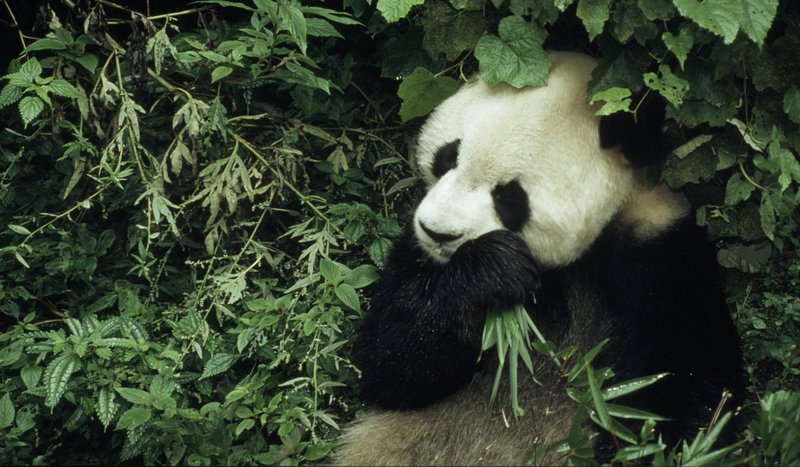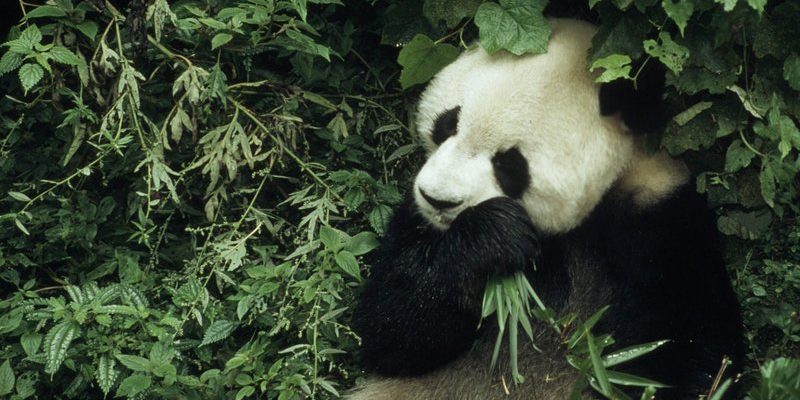
Pandas primarily reside in the mountain ranges of central China, specifically in bamboo forests. Their diet consists almost entirely of bamboo, which might seem simple, but it’s crucial for the health of the forest. By munching on bamboo, giant pandas help manage the growth of this plant, creating space for other plants to flourish. It’s like how we prune our gardens to encourage new growth—you create room for other life forms to thrive. Let’s dive deeper into how these fascinating animals impact their ecosystem.
1. Bamboo: The Staple of the Giant Panda
Bamboo isn’t just a favorite food for pandas; it’s their entire existence. Did you know that pandas eat various types of bamboo? There are around 40 different species available in their habitats, but they have their favorites, like the moso bamboo. Each day, a panda can consume up to 40 pounds of it! This massive intake is necessary because bamboo is low in nutrients, making it crucial for the pandas to eat a lot to get what they need.
But here’s where it gets interesting. By munching on bamboo, pandas help control its growth. Too much bamboo can lead to a monoculture, where one type of plant takes over and crowds out other species. By feeding on bamboo, pandas allow space for other plants and animals to thrive, promoting biodiversity in their ecosystem. This creates a healthier environment where various species coexist.
Why Bamboo Matters
You might be asking, why should we care about bamboo? Well, bamboo forests support a variety of wildlife, including birds, insects, and small mammals. When pandas keep these forests healthy, it enhances the habitat for countless other species. Imagine a bustling community where everyone plays a part—it’s the same concept in the forest, and pandas are like community leaders!
2. Acting as a Keystone Species
So, what exactly is a keystone species? Think of it as a critical player in an ecosystem. The presence of a keystone species, like the giant panda, has a disproportionately large effect on its environment. If you were to remove them, the entire system could crumble.
Giant pandas help maintain the balance between different plant species, which supports other animals that depend on these plants for food and shelter. For instance, when pandas consume bamboo, they leave behind gaps in the forest. These gaps allow sunlight to reach the forest floor, enabling other plants to grow. This, in turn, creates a more diverse habitat for birds and small mammals. Without pandas, the ecosystem could degrade, leading to less biodiversity and a less resilient environment.
Creating New Habitats
Pandas aren’t just munching machines; they’re also creating habitats. Their foraging behavior opens up spaces in the forest, which can allow other flora and fauna to thrive. The health of one species directly influences the health of others, making it clear that pandas are not just cute—they’re vital.
3. Influence on Soil Quality
Another interesting aspect of the giant panda’s role in its ecosystem is how they influence soil quality. When pandas consume bamboo and other plants, they don’t just stop at chewing. Their waste, which is rich in nutrients, acts as a natural fertilizer for the soil. This nutrient cycling is important because it enhances soil quality, promoting the growth of various plants, including those that might not thrive otherwise.
Additionally, the digging and movement of pandas through their habitats help aerate the soil. Think of it like turning the earth in a garden; it allows for better water absorption and root growth. Healthy soil means healthy plants, which means a thriving ecosystem.
Supporting Plant Diversity
Healthy soil supports a wide range of plant species, which is essential to maintaining biodiversity. More plant species mean more food sources for different animals, contributing to a balanced ecosystem. So, when you look at the giant panda, remember that they’re not just cute cuddly creatures; they’re also key players in maintaining the health of their environment.
4. Cultural Significance and Conservation Awareness
Giant pandas are more than just wildlife; they’re symbols of wildlife conservation. They represent efforts to protect not only their species but also the environments they inhabit. As ambassadors for conservation, pandas help raise awareness about the importance of biodiversity and preserving habitats.
Zoos and conservation groups often use pandas as the face of their initiatives. When people see giant pandas, they can’t help but feel a connection, prompting more interest in conservation issues. This popularity leads to funding and support for habitat preservation projects, which benefit countless other species in the ecosystem.
Engaging the Community
Engaging local communities in conservation efforts is also vital. When people recognize the importance of pandas, they often become more active in protecting the forests that sustain them. This community involvement is crucial for ensuring the health of the ecosystem that supports both pandas and people.
5. The Ripple Effect of Loss
Now, let’s think about what could happen if giant pandas were to disappear from their ecosystem. The loss of this keystone species would create a ripple effect, leading to declines in plant diversity and other animal populations that rely on those plants. It could lead to a less resilient ecosystem, making it more vulnerable to diseases and environmental changes.
Imagine tipping over that balance scale we talked about earlier; everything becomes unstable. In essence, protecting giant pandas isn’t just about saving one species; it’s about preserving the intricate web of life that depends on them.
Climate Change and Its Impact
Climate change poses a significant threat to giant pandas and their habitats. As temperatures rise, the suitable areas for bamboo growth may shift, affecting the availability of food for pandas. Understanding these dynamics is crucial for developing conservation strategies that can help mitigate these impacts and ensure the survival of not just pandas but their entire ecosystem.
6. Taking Action: How You Can Help
You might be wondering how you can contribute to the conservation of giant pandas and their ecosystems. Every little bit helps, and there are several ways to get involved:
- Support Conservation Organizations: Look for organizations that focus on panda conservation.
- Spread Awareness: Share information about the importance of pandas and their habitats with others.
- Reduce Your Carbon Footprint: Engage in practices that fight climate change, such as using public transport or reducing waste.
- Visit Zoos Responsibly: Support zoos that participate in conservation efforts and educate the public.
By taking these small steps, you can play a part in ensuring that the giant panda continues to thrive in its ecosystem.
The giant panda is much more than a cute face; it’s an essential player in its ecosystem. From maintaining bamboo forests to enriching the soil, pandas contribute greatly to environmental health and biodiversity. They serve as symbols of conservation, reminding us that our actions can make a difference.
So next time you see a panda, think about their role in the larger picture. They’re not just adorable creatures; they’re vital to the balance of their habitat and, ultimately, to our planet. By supporting their conservation, we can help ensure that these magnificent animals continue to thrive for generations to come.

